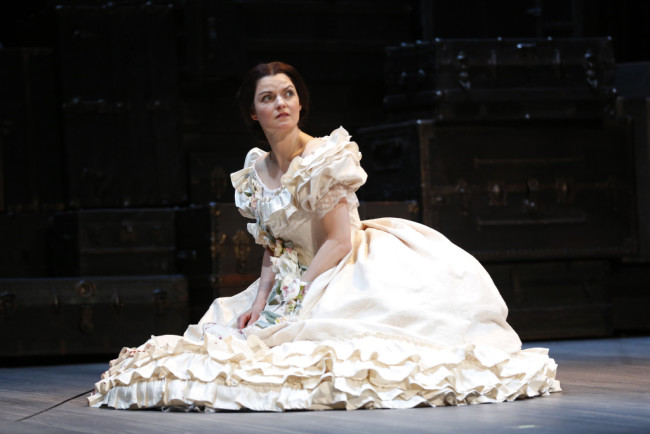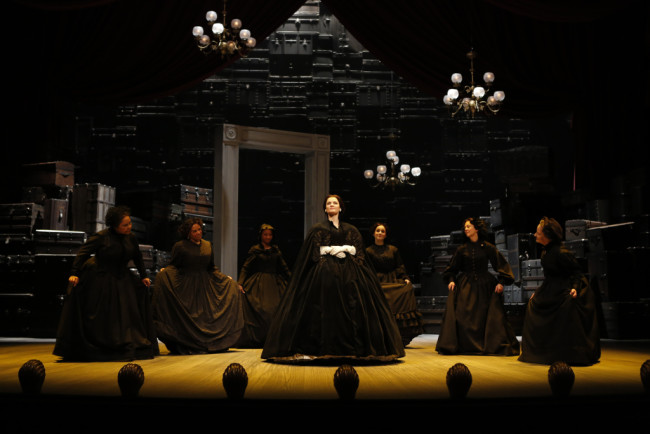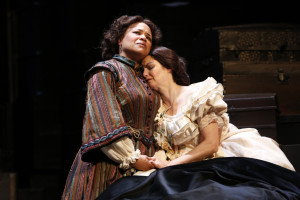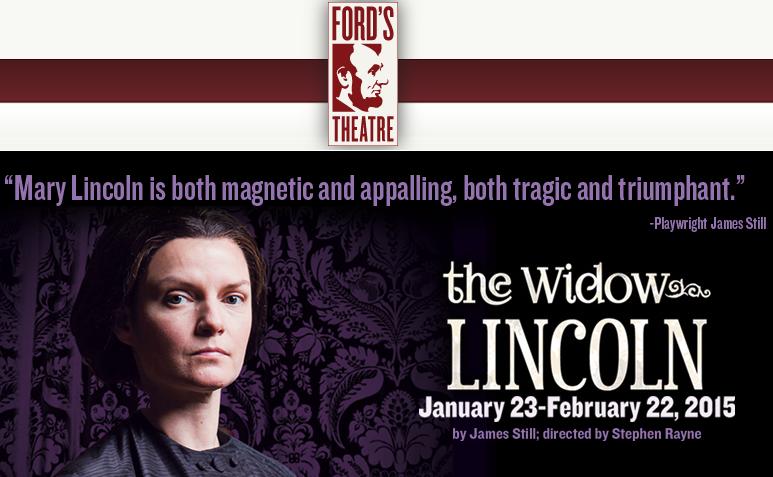Who is dead in the White House? A haunting question that repeats itself in the grief-stricken mind of a recently widowed first lady. Commemorating the 150th year since President Abraham Lincoln’s assassination, Ford’s Theatre has commissioned a work that captures the essence of the aftermath as told through the eyes of the eyes of Mary Todd Lincoln. Written by James Still and Directed by Stephen Rayne, this powerfully evocative drama enchants the audience into a surrealistic world of grief and mourning; time waits for no man not even the great father of the nation once death has played its hand. A stirring emotional journey; this harrowing reckoning of the president’s assassination and the effect the aftermath took upon not only his widow but the nation is a truly gripping theatrical experience. Poignantly penned to perfection by Still, this striking drama articulates the raw feelings of a nation in mourning even 150 years later.
Is there anything more irresistible than a brand new work of theatre to trod the boards of the historically iconic Ford’s Theatre while simultaneously stirring up the ghosts of what makes that theatre so significant? Playwright James Still captures a multitude of spirits both in living memory and those of the more ephemeral nature in this script. His inebriating use of textual repetition disorients the audience in a dizzying and pleasurable fashion; the inexplicable daydream of nightmares playing out with an intoxicating sensation of gloom juxtaposed against determination. Still entreats theatergoers to a rarely seen vulnerability in Mary Todd Lincoln; a fortitude that goes beyond the touched madness so often attributed to the First Lady of the Lincoln administration.
The emotional catharsis captured in the struggle of his portrayal of the widowed Mary Todd Lincoln is harrowing and realistic. The only fault to be found in Stills’ work is the irreverent nature in which Queen Victoria’s letter is carelessly dropped into the mechanism of the show. Despite its basis in reality the absurdity of its delivery and by extent its humorous vein cheapens the sentiment intended behind the historical event. This aside, Still’s impeccable conception of grief and its stages are lined out brilliantly in the work and delivered with poignant perfection by the cast.

Scenic Designer Tony Cisek blurs the lines of the widow Lincoln’s reality in his structural setup, aided by Lighting Designer Pat Collins. The enormity of the trunks, seeming to spiral endlessly backward into the recesses of the stage, consumes the stage like the dreary shadow of grief and loss consumes the title character. It is Collins’ eerie moving lights that appear to make the room alive; a pulsating element that seems to breathe of its own accord. With the elements working in tandem, Cisek and Collins successfully distort reality in a subtle fashion, keeping the audience just at the edge of this questionable reality while daring us to flirt with the surreal nightmare that turns the restless mind of the mourning widow.
Costume Designer Wade Laboissonniere is to be commended for the authenticity of the garments bestowed upon the characters in the production, particularly the costume reveal presented at the top of the play. The black garments that are ever present among the ensemble help to cement that interminable mourning period that shrouds the performance; perpetuating a sense of deeply embedded loss among all the characters.
It’s the striking soundscape created by designers David Budries and Nathan A. Roberts that creates a through line of connectivity across the performance. Again the use of repetition comes into play. A harrowing drop of metal against porcelain or the subtle hint of breathing and rhythmic heart pulse echoing and burbling in the underscoring of scenes creates a surreal aural experience in the atmosphere. The original compositions included by Budries and Roberts enhance the performance as well; a truly captivating design element that grounds the audience in Mary Todd Lincoln’s distorted and yet highly realistic reality.
Director Stephen Rayne works to maximize the haunting effect of the ensemble in this production with his placement and delivery of the three main ensemble speakers— Sarah Marshall, Lynda Gravàtt, and Gracie Terzian. Perched like vultures up in the recesses of the stacks of trunks, this trio of women take on symbolic notions of mourning shadows of time. Rayne hints at the symbolic representation of the three fates with their precise placement, looming over the scene as it plays out; their narrative delivery chilling to deep points of the soul. Their observations, delivered slowly with purposeful cadence— particularly when Sarah Marshall who is often featured at the center of the fixtures speaks— harkens a somber and morose tone for the play as it progresses. Yet there is something profound in Rayne’s execution of these grieving vultures; ever watching, ever commenting, and ever present.
Marshall, who doubles later in the show as Queen Victoria, has the most notable presence of the three main mourners. Her deliberate pacing in her delivery of the line, “…of the president’s open coffin” is profoundly haunting. Terzian doubles as the flighty Nettie Colburn, psychic medium extraordinaire and her moment in attempting to channel results in a curious dual portrayal worth noting. Gravàtt doubles as Mammy Sally, a comforting but stern presence when Mary Todd Lincoln truly feels her tether to reality slipping from her grasp. These three women provide mesmerizing portrayals both as the pillars of grief and as the characters they represent to the title character.
A soldier assigned to guard the First Lady, makes an appearance throughout the production. Melissa Graves takes to the role naturally but for fear of divulging too much of the character’s purpose to the plot, that is all that can be said of Graves’ work at present. The young servant girl, played by Brynn Tucker, is worth mentioning as well. She only receives one speech late in the show, but does so with fearful vigor and makes her presence felt when she addresses Mrs. Lincoln.
Laure Keene (Kimberly Schraf) is but a memory or a dream. Schraf embodies the remembered dreamlike character as if she were real; her interactions with Mrs. Lincoln poised but poignant. She knows her place is not of linear time in present reality but one of recollected existence and plays the character accordingly. The lilted airiness with which she speaks does her character’s status as an actor great justice while simultaneously enhancing her existence as little more than a figment of the First Lady’s imagination.

Elizabeth Keckly (Caroline Clay) is a triumphant force that grounds Mrs. Lincoln in the present moment especially when her mind begins to wander. Clay is fierce in her delivery, stalwart in her commands, and sagely in her given wisdom. Playing opposite the leading woman, Clay holds her own on the stage in moments when tempers flare and the madness of Mrs. Lincoln swallows up the scene.
Mary Bacon is a true sensation of the stage taking on the title role in this production. Giving a tumultuous performance that spans the emotional gambit she thrives in a heightened state of existence. From the opening scene where her bubbling enthusiasm is frothing over at the brink to the closing scene where a fortified woman of dignity marches proudly from the room, Bacon delivers an undeniable masterpiece of a performance. Even her more jubilant moments, Bacon has a jittery nervousness bubbling beneath the surface; a weathered pain and sorrow that cracks at the façade of her cheer. Her accent and manner of speaking are exactly as one might imagine the First Lady to have spoken given what is historically known of her.

Bacon exposes vulnerability within Mary Todd Lincoln, showing the world more than just the madness that consumed her. Endearing this simultaneously frail and determined woman to the audience with vigorous compassions, Bacon is engulfed in a fiery bed of tempestuous dueling emotions, all of which show readily in her portrayal of this iconic woman. Tempering the terrified hysteria with the forthright attitude of determination, Bacon imbues Mary Todd Lincoln with a raw and unforgiving humanity that sets the stage ablaze in both moments of high conflict and silent sorrow. A phenomenal performing sensation; Bacon is not to be missed in this role of a lifetime.
Time is a burden. And a gift. Make it your gift to find the time to see this exceptional production at Ford’s Theatre lest you bear the burden of missing such a marvelous and truly striking performance.
Running Time: Approximately 2 hours and 30 minutes with one intermission
The Widow Lincoln plays through February 22, 2015 at Ford’s Theatre— 511 10th Street NW in Washington, DC. For tickets call the box office at (202) 347-4833 or purchase them online.

